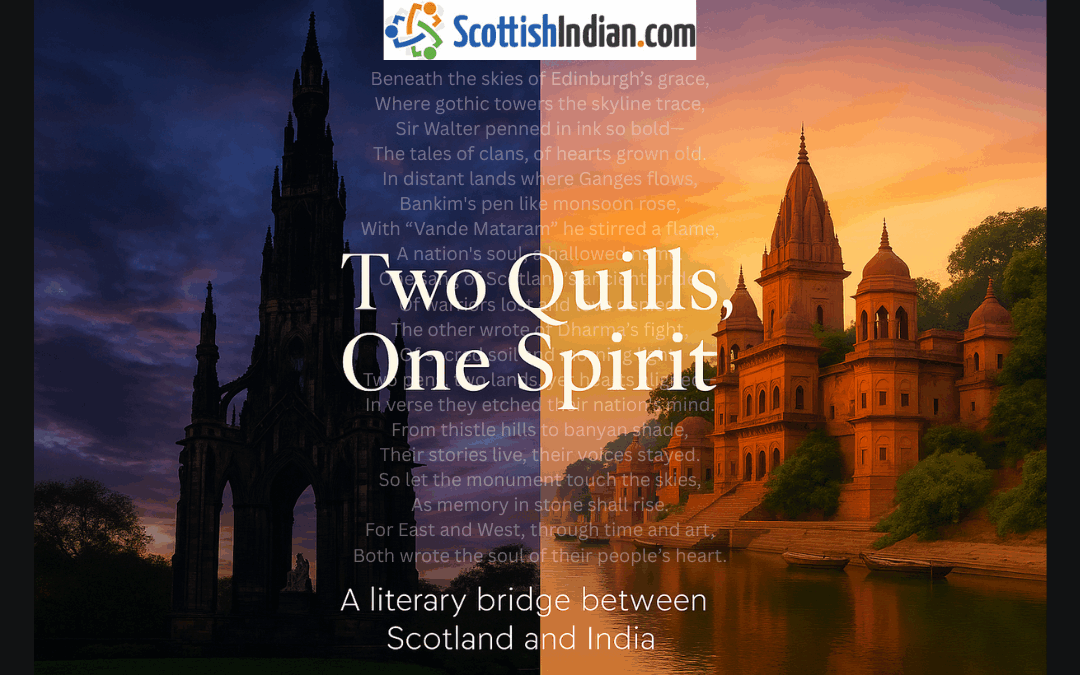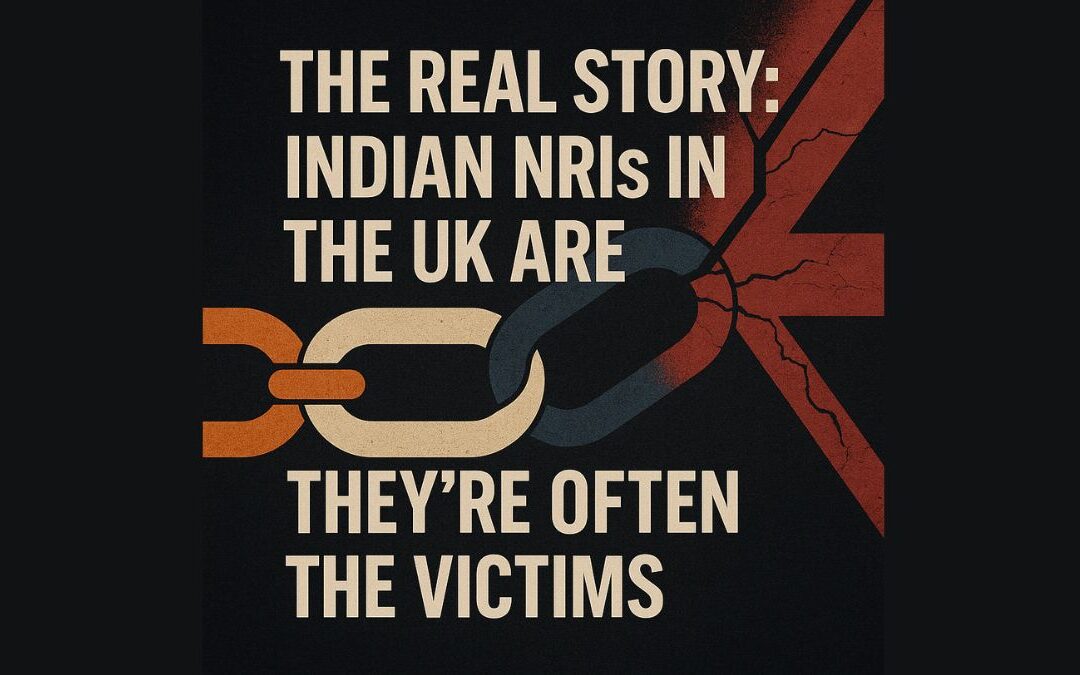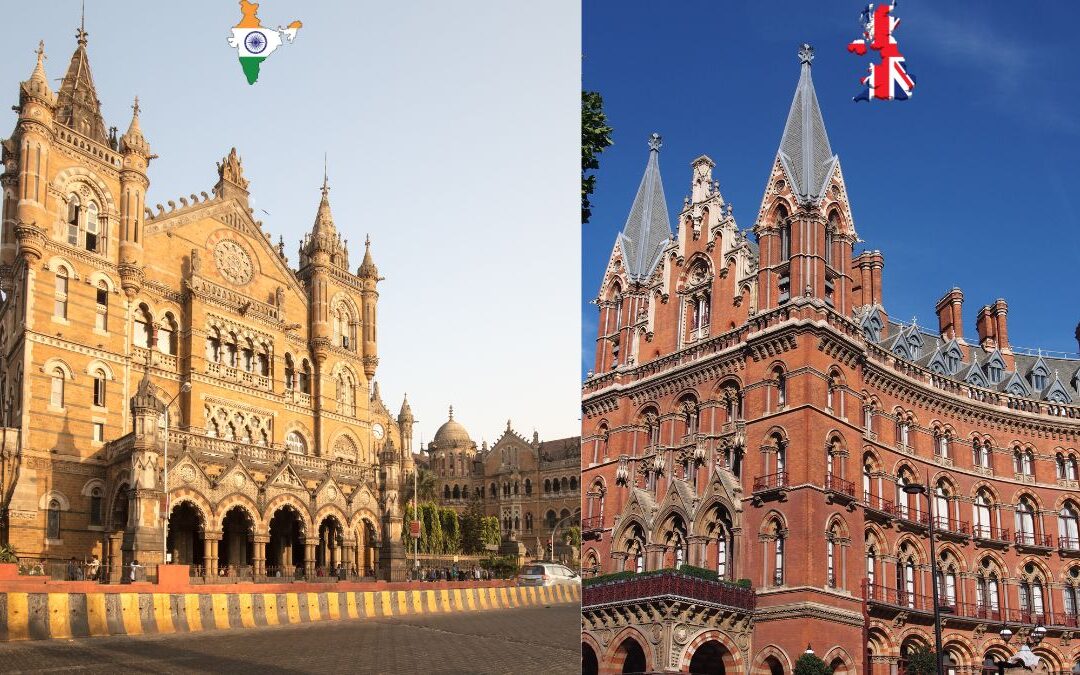
by Soniya Basu | Jun 2, 2025 | Cultural Integration, Culture & Community
Beneath the soaring spire of the Scott Monument in Edinburgh, one reflects on the enduring power of storytelling. Especially when considering the literary legacy of Sir Walter Scott and Bankim Chandra—two voices separated by continents but united in purpose.
🖋️ Two Quills Across Continents
Sir Walter Scott, immortalized in stone beneath the gothic arches, was more than a novelist. He was the voice of a nation, shaping Scotland’s soul through verse and fiction.
Thousands of miles away, in a land equally steeped in history and complexity, another quill was at work—Bankim Chandra Chattopadhyay.
Though they never met, and though they wrote in different languages and times, Scott and Bankim Chandra shared something powerful. They both believed literature could shape a nation. Their pens were swords. Their ink, a balm and a beacon.
For instance, Scott’s works, from Waverley to Ivanhoe, romanticized Scotland’s past. He brought Highlanders, heroes, and haunting landscapes to life. He built national pride not through manifestos but through stories. By blending folklore, myth, and memory, he gave Scotland a voice in an age of cultural suppression.
Similarly, Bankim Chandra—often called the father of the Indian novel—carried a torch for India’s identity. With Anandamath and the song “Vande Mataram,” he ignited Indian nationalism through fiction. His stories mixed history with spiritual and moral questions. He gave readers not just stories, but purpose and unity under colonial rule.
Their similarities are striking. Both drew inspiration from their land. Both used narrative to protect cultural identity. And both showed that words, when used with heart and conviction, can move people more than any speech or weapon.
The impact of Sir Walter Scott and Bankim Chandra goes beyond their era. Their words remain timeless.
As I stood before the Scott Monument, I thought of Bankim Chandra. I felt the invisible thread between them—a literary kinship that defied geography. Scott carved Scotland into legend. Bankim sang India into being.
In fact, their legacy lives beyond books and statues. It lives in the spirit of two nations shaped by stories and imagination.
✍️ Poetic Tribute: Two Quills, One Spirit
Beneath the skies of Edinburgh’s grace,
Where gothic towers the skyline trace,
Sir Walter penned in ink so bold—
The tales of clans, of hearts grown old.
In distant lands where Ganges flows,
Bankim’s pen like monsoon rose,
With “Vande Mataram” he stirred a flame,
A nation’s soul, a hallowed name.
One sang of Scotland’s ancient pride,
Of warriors lost and love denied.
The other wrote of Dharma’s fight,
Of sacred soil and morning light.
Two pens, two lands, yet hearts aligned—
In verse they etched their nation’s mind.
From thistle hills to banyan shade,
Their stories live, their voices stayed.
So let the monument touch the skies,
As memory in stone shall rise.
For East and West, through time and art,
Both wrote the soul of their people’s heart.
The stories of Sir Walter Scott and Bankim Chandra Chattopadhyay remind us that culture and imagination know no borders. At ScottishIndian.com, we celebrate the vibrant threads that connect Scotland and India—through art, literature, music, and everyday moments.
👉 Explore more cultural connections in our Blogs or join the conversation in our Whatsapp Community.

by Soniya Basu | May 30, 2025 | Cultural Integration, Culture & Community
On behalf of all Indian Immigrant in the UK
The Convenient Blame Game
In times of social anxiety and economic strain, immigrants are often the first to be blamed.
“You’re taking our jobs.”
“You’re changing our culture.”
“You don’t integrate.”
For Indian NRIs (Non-Resident Indians) in the UK, this rhetoric is familiar. But what’s rarely acknowledged is the irony behind it: those accusing us of cultural disruption come from a nation with centuries of history exporting its own culture—mostly forcefully—around the world.
From Colonisers to Critics: The Cultural Struggle of Indian Immigrants in the UK
Between the 17th and 20th centuries, Britain colonised nearly a quarter of the world’s land and people. It didn’t just extract resources but topped it with exported British laws, religion, education systems, and values to countries that never asked for them. 👉 Learn more: BBC Bitesize – British Rule in India
- Indian languages were replaced in schools by English.
- British Christianity was promoted at the expense of native faiths.
- Local governance and community systems were dismantled.
- Entire generations were taught to think in ways that favoured the coloniser’s worldview.
In short: British colonialism wasn’t cultural exchange. It was cultural domination.
And yet today, when Indian immigrants politely cook their food, wear their clothes, and speak their languages within their own communities, they’re told they’re “not integrating” or “changing the British way of life.”
Really?
Indian NRIs in the UK are not coming to impose. We are not missionaries. We are not rewriting your schoolbooks. We are not asking for Britain to change its identity.
We are doctors in your hospitals, educators in your schools, and researchers in your universities.
Our presence is felt not in disruption, but in contribution—often more than we receive. 👉 Explore: MEA – Indian NRI Global Contributions
We are contributing—often more than we receive. And yet, we face:
- Systemic discrimination in jobs and housing
- Underrepresentation in leadership positions
- Racism, both overt and subtle
- Visa insecurity, despite years of tax-paying contribution
- And worst of all, constant suspicion—as if we’re here to take something rather than give.
👉 Read more: India Today – Indian Diaspora and UK Politics
Indian NRIs in the UK vs. Colonial Memory: Who’s Reshaping Culture?
Is it the Indian family quietly celebrating Diwali with their neighbours?
Or the British Empire that rewrote entire cultures for centuries, from Bengal to Jamaica?
Is it the Indian software engineer coding British fintech products?
Or the colonial administrators who removed local governance systems and replaced them with laws that privileged the coloniser?
Let’s not pretend this is about “cultural preservation.”
It’s about control. And it’s about memory ,specifically, selective memory.
Specifically, the kind of memory that remembers only what flatters the mirror. A rich culture of remembrance, if only there had been one to begin with.
The truth is, India today is confident in its culture. Despite centuries of oppression, we have preserved our languages, our traditions, our values. And now, as India rises on the global stage, its diaspora reflects that same confidence. Thus, India’s cultural confidence is a victim to Britain’s cultural anxiety.
We don’t want to erase anyone else’s identity. We just want to exist with dignity.
Yet here in the UK, where identity is increasingly politicised, immigrants become easy targets for the things that have gone wrong. Whether that’s in the economy, public services, or social cohesion — which is a result of unplanned governance on theirs.
But here’s the uncomfortable truth: Indian NRIs are not breaking the system. We’re often the ones helping to keep it standing.
Why Indian Immigrants in the UK Deserve Respect, Not Rejection
British society often asks immigrants to “assimilate”—which is really just a polite way of saying, “Could you maybe not look so… immigrant?”
But look closely, and you’ll see: it’s not Indian culture that’s the threat. It’s the unwillingness of systems to include anything unfamiliar.
Wearing sarees and turbans is how we honour our roots—not a statement of separation.
Speaking Hindi or Tamil connects us to generations before us.
And when we celebrate our festivals, it’s to enrich the shared cultural fabric—not disrupt it.
This isn’t an invasion.
This is coexistence.
We don’t want domination, look back in history, we’ve seen what that looks like. We still live with its consequences back home. What we want is:
- Respect for our contribution
- Fair opportunity
- Space to be ourselves without suspicion
- And a recognition that integration is a two-way street
We are not asking Britain to apologise for the past—but we do ask that it not repeat it in modern form.
If Indian immigrants seem protective of their culture, perhaps it’s because we’ve seen what happens when it’s taken away.
If we seem quiet in the face of injustice, perhaps it’s because we’ve learned to endure.
But don’t mistake that silence for consent.
And don’t mistake our presence for imposition.
We didn’t colonise anyone.
We didn’t rewrite history.
About the Author
An Indian immigrant in the UK who believes in cultural coexistence, historical clarity, and building bridges without losing roots. A firm believer that progress doesn’t require erasure but only requires respect.
👉 “For more real stories and cultural perspectives, visit our Community Blog or sign up for our newsletter.”

by Soniya Basu | May 27, 2025 | Cultural Integration, Culture & Community
Miss Scotland Miss World 2025 Hyderabad is more than a beauty pageant headline — it’s a celebration of heritage, strength, and identity. As the world watches the 72nd Miss World unfold in Hyderabad, India, Miss Scotland brings with her more than just elegance. She represents a legacy of strong women, Scottish heritage, and the spirit of cross-cultural exchange that resonates deeply with the ScottishIndian community.
One of Amy’s most meaningful moments took place at the Telangana Police Headquarters. Contestants were welcomed by a live pipe band — playing the Scottish national instrument, the bagpipes.
This was more than just a performance. It was a proud moment. Amy said, “Seeing the band in the tartan and hearing the music made me feel so proud of my heritage.”
Scottish culture was honored far from home — and right in the heart of India.
A Shared Legacy: Women in Policing from Scotland to Hyderabad
This visit held special meaning for Amy. Her family has served in policing for three generations. Her mother became one of the first female officers in Scotland to return to work after having a baby. This was rare and discouraged at the time.
Her mum rose to the rank of Assistant Chief Constable — while raising five children. Amy shared how proud she is of her mother’s journey. She also praised the Telangana Police for their strong focus on women’s safety.
From women-only transport to dedicated helplines, their work stood out. Amy found it inspiring to see so many female officers leading change.
A Warm Welcome in Hyderabad
After the police visit, the contestants were hosted at the Telangana Secretariat. They enjoyed a beautiful ceremony and high tea. A stunning drone show followed, telling the story of Telangana’s history and culture.
Amy called the experience “unbelievable” and said she felt deeply welcomed throughout the visit.
Scottish Heritage Meets Global Stage at Miss World 2025
During the Top Model Final, Amy wore a gown she designed herself. It was made from 100% Scottish wool, in a bold green tartan. The fabric was gifted by @glenislakilts.
Her look paid tribute to the Scottish Lowlands. It was more than fashion — it was a proud statement. She brought her heritage to the world stage, beautifully blending tradition with modern elegance.
Amy Scott’s presence at Miss Scotland Miss World 2025 Hyderabad is more than symbolic. She’s telling a story of strength, identity, and legacy — one that resonates far beyond the stage. And she’s doing it in India, a country with deep meaning for the ScottishIndian community.
We’re proud to follow her journey — from Strathaven to Hyderabad.
Stay with ScottishIndian.com for more stories that celebrate identity, beauty, and cross-cultural pride.
👉 Learn more about who we are.

by Soniya Basu | May 21, 2025 | Cultural Integration, Culture & Community
In a striking blend of cultures, history, and architectural brilliance, St. Pancras CSMT is a tale of two iconic train stations that connect London and Mumbai through shared design heritage. Mumbai’s Chhatrapati Shivaji Maharaj Terminus (CSMT), formerly Victoria Terminus, owes much of its Victorian Gothic grandeur to London’s legendary St. Pancras Station.
It’s a UNESCO World Heritage Site that beautifully fuses Indian craftsmanship with Victorian Gothic Revival design, and its architectural lineage points directly to one of London’s most treasured buildings: St. Pancras International Station.
A Tale of Two Stations: East Meets West
Built in 1887 to commemorate Queen Victoria’s Golden Jubilee, CSMT was designed by British architect Frederick William Stevens. He took clear inspiration from the grandeur and structural innovation of St. Pancras Station in London, which had opened just two decades earlier in 1868.
Both stations share hallmark features of the Victorian Gothic Revival style, including:
- Ornate stone carvings
- Pointed arches and ribbed vaults
- Dramatic domes and spires
- Stained glass and high, vaulted ceilings
- Clock towers as central visual elements
But CSMT brings its own flair. An Indian soul woven into a British skeleton. The building is richly adorned with local motifs, floral patterns, and sculptures of animals, creating a breathtaking hybrid style known as Indo-Saracenic Gothic.
Why London’s St. Pancras or Mumbai’s CSMT Still Matters Today
More than 135 years later, both St. Pancras and CSMT remain active, iconic landmarks — but their cultural importance goes far beyond train travel.
- CSMT is a symbol of Mumbai’s colonial history and post-independence resilience
- St. Pancras stands as a gateway to Europe and a masterpiece of Victorian engineering
- Together, they tell a story of global design exchange, long before Instagram made aesthetics go viral
For travellers, architecture lovers, and history buffs, these stations are more than transit points — they’re living museums of a shared past.
The visual connection is part of a broader narrative — one where colonial design, local artistry, and urban identity blend across continents. You can see Victorian Gothic style echoed in buildings from Chennai to Cape Town, Kolkata to Kuala Lumpur.
Planning to Visit London’s St. Pancras or Mumbai’s CSMT?
- In London? Don’t miss a walk through St. Pancras — admire its clock tower, red brick façade, and grand interior
- In Mumbai? Head to CSMT in the evening when it’s beautifully lit, and take a moment to absorb the craftsmanship up close
You’ll see how one city’s vision inspired another’s masterpiece — and how both continue to stand tall in a world that’s ever-changing.
Want more culture-spanning stories like this? Explore our Culture section for deep dives into art, architecture, and travel through an Indian lens.
Are you a Scottish Indian business looking to reach more customers? List your business in our directory today and connect with a vibrant community!“

by Soniya Basu | May 16, 2025 | Cultural Integration, Culture & Community
Understanding the Rise of Desi Influence in British Politics | ScottishIndian.com
Did you know that Indian-origin voters are now one of the most influential voting blocs in the UK? From local council seats to Westminster whispers, the British Indian community is shaping the future of UK politics — and Gen Z and millennial desis are right in the middle of it.
At ScottishIndian.com, we don’t just help you with visas, food hacks, or travel tips — we care about how you find your voice in your new home. So let’s unpack why Indian voters in the UK are becoming a powerful political force — and how that matters for students, professionals, and families like yours.
🇮🇳 First Things First: How Big Is the Indian Community in the UK?
There are over 1.8 million people of Indian origin in the UK, making it the largest ethnic minority group. In Scotland alone, the Indian community is growing steadily — with strong roots in Glasgow, Edinburgh, and Dundee.
Add to that the rising number of Indian students, skilled workers, and second-gen desis, and you’ve got a community that’s young, vocal, and increasingly aware of its voting power.
🗳️ So, Why Are We Becoming a Power Bloc?
1. Sheer Numbers + Voter Turnout
Indian-origin voters turn out to vote at higher rates than many other ethnic groups. We care about education, immigration, the economy, and healthcare — and we show up to have our say.
2. We’re Swing Voters
British Indians aren’t locked into one party. We vote based on issues, not identity — and politicians know that. That makes us a key swing vote in many marginal constituencies.
3. We’re Politically Aware
From WhatsApp debates to Insta reels on politics, young British Indians are engaged. More desi youth are joining university politics, community activism, and even running for office.
🧠 Issues That Matter to Desi Voters
Whether you’re a student in Glasgow or a business owner in Leicester, here are the issues we care about:
- Immigration policy — especially post-Brexit changes and family reunification
- Education and student fees
- Economic growth and job opportunities
- Recognition of Indian festivals, faith, and culture in local policy
- Foreign policy with India — especially during times of tension
💬 Final Thoughts from ScottishIndian.com
The rise of Indian-origin MPs, the visibility of British Asian mayors, and the influence of desi business networks prove one thing: we’re no longer just participants — we’re influencers in UK politics.
At ScottishIndian.com, we believe knowing your power is the first step to using it.
So whether you’re eligible to vote today or gearing up for it tomorrow, remember this: Your voice matters. Your vote counts. Your impact is real.
Check out our Culture section for more.

by Soniya Basu | Apr 21, 2025 | Cultural Integration, Culture & Community
What It Means for the Hindu Community & Why It Matters for Us All
Something historic just happened — Motion Against Hinduphobia and if you’re part of the Scottish Indian community, it’s a moment you’ll want to know about.
In 2025, Scotland officially introduced its first-ever parliamentary motion addressing Hinduphobia — a powerful recognition of discrimination faced by Hindus, and a major step toward inclusion and equality. For thousands of Hindus in Scotland — from students to working professionals and families — this motion is more than just political paperwork. It’s a moment of visibility, validation, and solidarity.
At ScottishIndian.com, we celebrate these milestones because we believe in representing our stories, faith, and lived realities in public life. So let’s break down what this motion actually means — and why it’s a big deal for our community.q
🧭 What Is the Motion About Hinduphobia?
On April 8, 2025, Member of the Scottish Parliament (MSP) Ash Regan of the Alba Party tabled Motion S6M-17089, titled “Gandhian Peace Society’s Report to Address Prejudice Against Scotland’s Hindu Community.”
The motion commends the Gandhian Peace Society’s report, “Hinduphobia in Scotland,” which highlights rising levels of prejudice, discrimination, and marginalization experienced by members of Scotland’s Hindu community. It acknowledges the importance of the Society’s research, advocacy, and public engagement in raising awareness and advancing interfaith dialogue, social cohesion, and mutual respect across Scotland’s diverse communities.
The motion further notes the report’s contribution to fostering constructive discussions around safeguarding religious and cultural rights and encourages continued collaboration to build a more inclusive and equitable society.
💬 “It’s about giving voice to a peaceful, ancient tradition that’s long been misunderstood in modern Western contexts.”
📍📖 The Report: Shedding Light on Prejudice
The Gandhian Peace Society’s report presents data and firsthand accounts detailing instances of Hinduphobia in Scotland. Notable incidents include:
- Vandalism of a Hindu temple in Dundee with hateful graffiti.
- An attack on a Hindu family’s home in Glasgow by masked individuals.
- A Hindu nurse in Edinburgh being denied a promotion and asked to remove her bindi and bangles.
- A Hindu teacher in Glasgow being accused of terrorism.
These accounts underscore the need for concerted efforts to address and eradicate Hinduphobia, as such incidents impact individuals and families directly and contribute to a broader atmosphere of discrimination.
🗣️ Voices from the Community for Hinduphobia
Dhruva Kumar, General Secretary of the Gandhian Peace Society, emphasized the significance of the motion, stating, “Regan’s motion sets a precedent: religious harmony is not passive; it is fought for, legislated, and cherished.”
Neil Lal, President of the Indian Council of Scotland and UK, remarked, “When places of worship are vandalised or families face slurs, it’s not just Hindus being attacked; it’s Scotland’s values of tolerance. This report is a mirror held up to our society, urging us to do better.”
🌍 Implications for the Scottish Indian Community
For the approximately 16,000 Hindus in Scotland, this motion represents more than symbolic recognition; it is a call to action. It encourages:
- Increased awareness and education about Hinduism in schools and communities.
- Support for interfaith initiatives promoting dialogue and understanding.
- Active participation in efforts to combat religious prejudice and promote inclusivity.
🙌 A Step Toward Unity and Empowerment
At ScottishIndian.com, we stand for unity, empowerment, and cultural pride. This motion reminds us that our voices matter — and that change is possible when communities speak up and get involved.
Here’s what you can do:
- Share this story on social media with your desi network
- Start or join Hindu societies on campus or in your city
- Encourage your local MSP to support inclusive policies
- Call out Hinduphobia when you see it — with facts and calm confidence
💬 Final Thoughts from Scottish Indian for Motion Against Hinduphobia
The passing of Scotland’s first motion against Hinduphobia is more than symbolic — it’s a sign that Scottish Hindus are being seen, heard, and respected.
As members of the Indian diaspora in UK, we now have a platform to stand on — let’s use it wisely.
📢 For more updates on Scottish politics, Hindu culture, and desi voices, follow ScottishIndian.com — your digital home in the UK.





